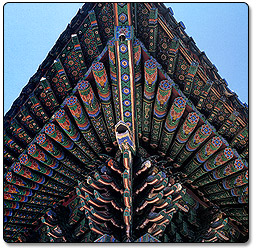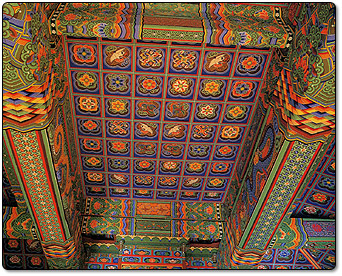|


"Tanch'ong"
 In
Korean, temples and palaces are painted in a particular
style called "tanch'ong". Tanch'ong means "red
and blue", the principal colours used in these colourful
cosmic designs. Originally arriving with Buddhism when it
was brought from China, the patterns of tanch'ong were modified
in Korea. Tanch'ong preserves the wood from insects and
the elements and adds glory and richness to the buildings. In
Korean, temples and palaces are painted in a particular
style called "tanch'ong". Tanch'ong means "red
and blue", the principal colours used in these colourful
cosmic designs. Originally arriving with Buddhism when it
was brought from China, the patterns of tanch'ong were modified
in Korea. Tanch'ong preserves the wood from insects and
the elements and adds glory and richness to the buildings.
The
outside eaves, the inside rafters and the ceilings are covered
with intricate tanch'ong patterns. On the main temple beams
and among the rafters, interwoven between the patterns,
you will find pictures of spirits, ancient monks, Bodhisattvas
and dragons, to name a few. It is said that during the Shilla
period, tanch'ong was even found on commoners' home. Now
it is limited to temples and palaces as well as some musical
instruments.
Buddhist
paintings are not only beautiful but also full of meaning.
Symbols are included in the paintings; beauty and meaning
are interrelated to instruct the visitor on his spiritual
quest, reminding him of the path.
 On
the outside ends of big buildings, up towards the roof,
you will see three circles. These represent heaven, earth
and man, the three important things that Tangun, the mythological
founder of Korea, is supposed to have brought with him.
They have come to represent the Buddha, his teaching and
the community of Buddhists. On
the outside ends of big buildings, up towards the roof,
you will see three circles. These represent heaven, earth
and man, the three important things that Tangun, the mythological
founder of Korea, is supposed to have brought with him.
They have come to represent the Buddha, his teaching and
the community of Buddhists.
Lotuses,
are another common symbol found in Buddhist paintings, are
to be seen in many forms. The lotus grows from mud (representing
ignorance) up to the clear sunlight (representing enlightenment).
The
symbol of the fish is often painted on the main Buddha table.
It represents the effort and determination necessary for
attaining enlightenment, for the fish supposedly, never
closes its eyes.
If
you look closely, you will find swastika everywhere: on
the outside of buildings, woven into patterns, even in the
decorations in the subways and in roadside railings. The
swastika is an ancient Buddhist symbol of peace, harmony
and good luck.

|
